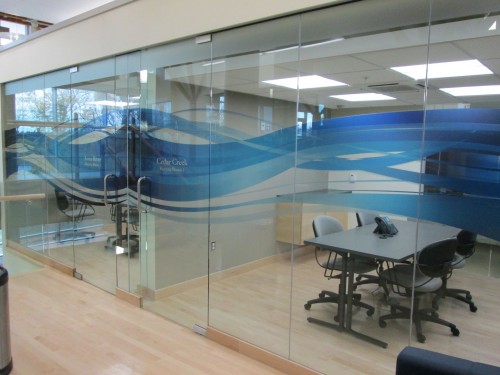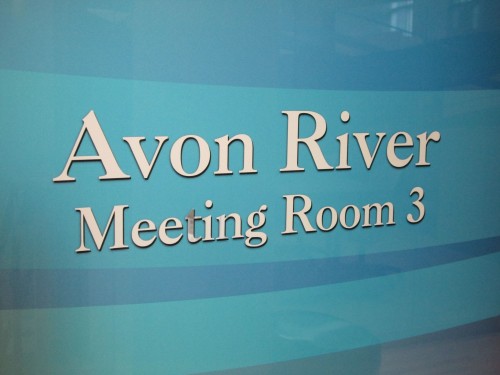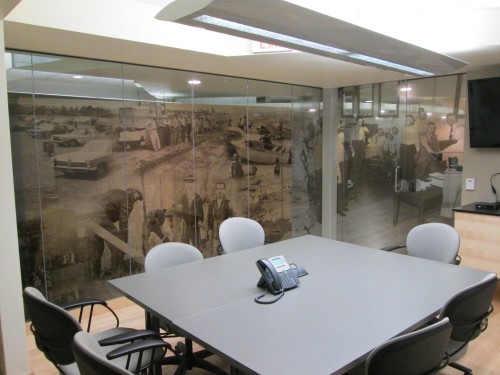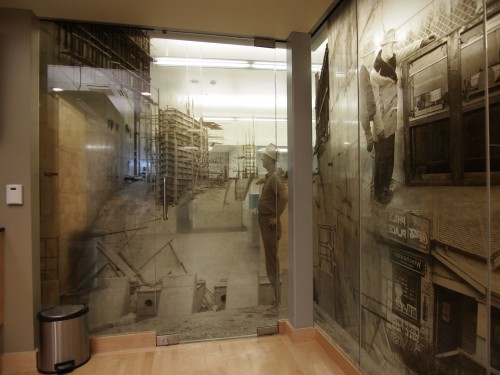Wide-format Printing: A new wave of window graphics
by all | 27 June 2014 1:30 pm
 [1]
[1]Photos courtesy WFS
By Peter Yates and Colin Chalmers
In 2012, the Upper Thames River Conservation Authority (UTRCA) in London, Ont., moved into new offices in an open-concept, Leadership in Energy and Environmental Design (LEED) certified building. While this building’s huge expanses of interior glass were an attractive part of its open concept, however, it meant all of the office partitions were wide open, without any privacy for their tenants.
UTRCA staff’s need for privacy created an opportunity to use the glass as a canvas for digitally printed images on optically clear films. In terms of interior décor, this was a chance to further beautify and personalize the office space. And it was a chance for local firm Window Film Systems (WFS) to showcase the possibilities of the relatively new and growing medium of printable clear films.
Mission: conservation
UTRCA and its counterparts across Ontario were formed after the provincial government passed the Conservation Authorities Act in 1946, with a mandate “to establish and undertake, in the area in which it has jurisdiction, a program designed to further the conservation, restoration, development and management of natural resources other than gas, oil, coal and minerals.” This initiative was undertaken in response to extensive soil loss and flooding in rural areas across the province due to earlier droughts and deforestation.
 [2]
[2]In addition to providing privacy and improving esthetics, the window graphics serve as wayfinding tools, displaying the names of their corresponding rooms.
Since then, watershed-based resource management has guided the conservation authorities’ ongoing planning and operations. UTRCA, as its name suggests, covers the upper watershed of the Thames River, an area of 3,482 km2 (1,344 sq mi) that is primarily rural, but also includes urban centres like London, Stratford and Woodstock, Ont., with a population of approximately 485,000.
The 17 municipalities within this heritage-designated watershed appoint representatives to UTRCA’s board of directors, who must then decide upon policies and programs to conserve the Thames. UTRCA also employs more than 72 full-time and contract employees and between 100 and 150 seasonal employees. Its services include flood control, environmental planning and monitoring, soil conservation, drinking water source protection, watershed planning and research.
Combining past and present
Discussion of the glass films project began when UTRCA reached out to WFS with an inquiry through the company’s website. At first, there was talk of using frosted-glass films, but the designer at UTRCA, Ryan McNaughton, soon realized he could accomplish much more esthetically by having custom images printed instead.
WFS got the go-ahead and worked with the design team to conceptualize all of the graphics that would be printed onto the clear films. This involved back-and-forth discussions and on-site visits to get a better sense of the space.
As the project developed, for example, one area of focus was UTRCA’s long history. Black-and-white photos taken as far back as the 1920s and ‘30s, depicting the region before the Conservation Authorities Act was passed, were incorporated into collages to cover the windows of two new meeting rooms.
In other spaces, on the other hand, it was more imperative to continue letting light through the glass, even while adding artwork to enhance privacy. To achieve the right balance between these needs, UTRCA designed more modern ‘fluid’ graphics, representing the flow of water as a theme, which would only obscure limited sections of the glass surfaces and would match the esthetics of the surrounding décor.
The films served other purposes beyond privacy and esthetics. For one thing, in terms of safety, they would help make people walking through the building aware of all glass barriers. For another, they would serve as wayfinding tools, displaying the names of their corresponding rooms.
Produced to size
After the initial designs were created, the windows throughout the building were measured and the graphic files were ‘tiled’ so as to accommodate all of the mullions, partitions and dividers. WFS then prepared space-specific proofs for the client to approve and sign off on.
 [3]
[3] [4] Collages of black-and-white photos from the 1920s and ‘30s were assembled to cover the windows of two meeting rooms.
[4] Collages of black-and-white photos from the 1920s and ‘30s were assembled to cover the windows of two meeting rooms.
To ensure fine details and vibrant colours, WFS printed the graphics in-house with a 1.6-m (64-in.) wide Roland DGA LEJ-640 hybrid flatbed ultraviolet-curing (UV-curing) inkjet printer onto Lintec of America’s E2200ZC scratch-resistant clear polyester film with UV inhibitors to prevent discolouration under sunlight.
Even though the graphics would take up only a small portion of the glass partitions’ and windows’ overall areas, the films were processed at full size to be applied to the entire surfaces, as the high clarity of the material would allow a perfect view through the glass where there were no graphics anyway. An added benefit of this approach was it meant no one could pick or scratch at the graphics, as the films ran fully from edge to edge.
Short timeline, big impact
The client wanted all of the work to be completed well before the building’s grand opening on May 31, 2013. Indeed, WFS had only a relatively short timeline of approximately four weeks to complete the project, toward the end of 2012.
The installation had an immediate effect on staff and visitors, serving both to start up new conversations and to help tell the story behind UTRCA. Those who had seen the new building take shape emphasized what a difference the graphics made to its appearance.
From concept and design to printing and completion of the project, the job met not only the client’s goals, but also WFS’s vision of a ‘flagship’ project to showcase its capabilities. Already, the project has led to considerable other opportunities, including some with the same architects and designers who worked on the UTRCA offices. In 2013, WFS worked with Hariri Pontarini Architects (HPA) on similar window-cling privacy graphics for the new Richard Ivey School of Business building at London’s University of Western Ontario (see Sign Media Canada, April 2014, page 26)[5].
For that matter, the UTRCA project is not done yet. Following the initial installation, WFS has completed three additional phases of full-colour and black-and-white graphics, including one that ran into early 2014.
As the fields of architecture and signage increasingly overlap, more designers, decorators and architects will turn to printable window films in the future.
Peter Yates is owner of and Colin Chalmers is a regional sales representative for Window Film Systems (WFS) in London, Ont., which distributes Lintec of America’s pressure-sensitive films in Canada. For more information, visit www.windowfilmsystems.com[6] and www.lintecofamerica.com[7].
- [Image]: http://www.signmedia.ca/wp-content/uploads/2014/06/IMG_0437.jpg
- [Image]: http://www.signmedia.ca/wp-content/uploads/2014/06/IMG_0440.jpg
- [Image]: http://www.signmedia.ca/wp-content/uploads/2014/06/IMG_0451.jpg
- [Image]: http://www.signmedia.ca/wp-content/uploads/2014/06/P1012549.jpg
- 26): http://www.kenilworth.com/publications/smc/de/201404/files/26.html
- www.windowfilmsystems.com: http://www.windowfilmsystems.com
- www.lintecofamerica.com: http://www.lintecofamerica.com
Source URL: https://www.signmedia.ca/wide-format-printing-a-new-wave-of-window-graphics/